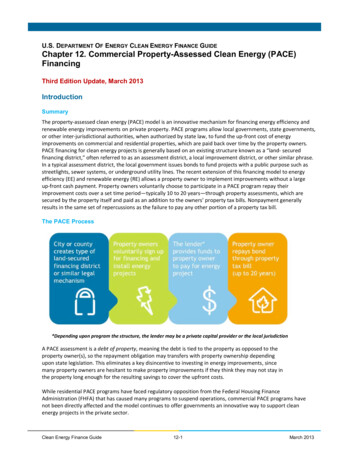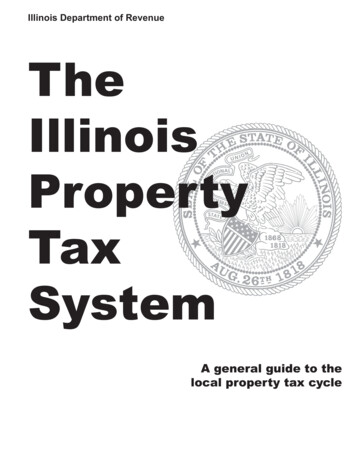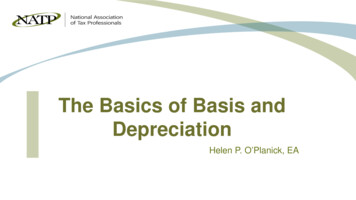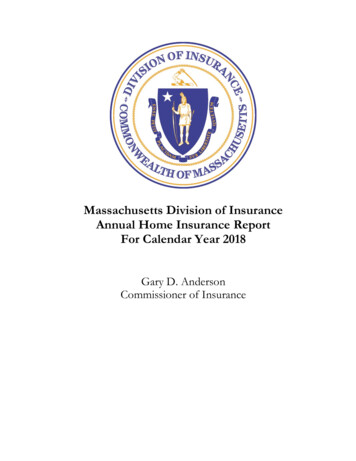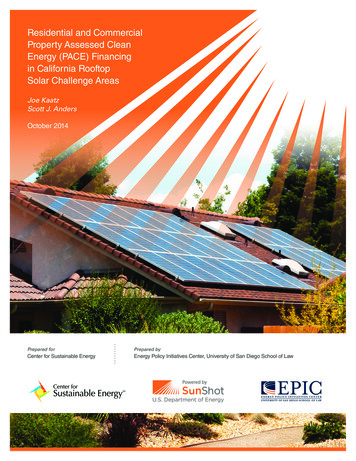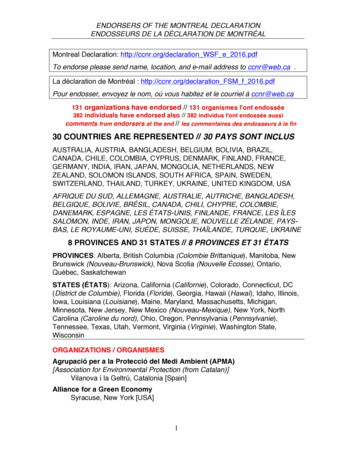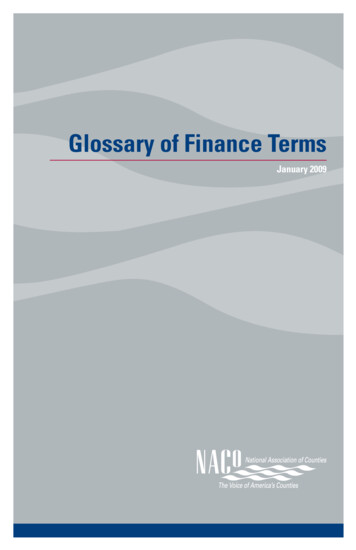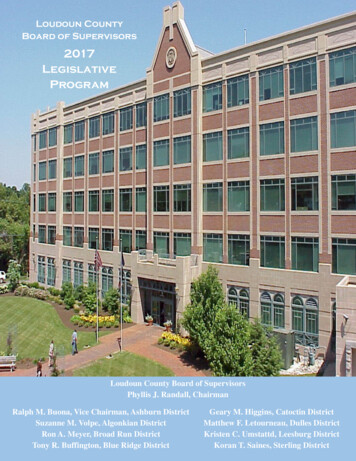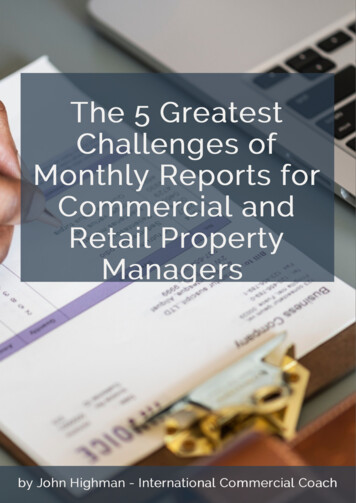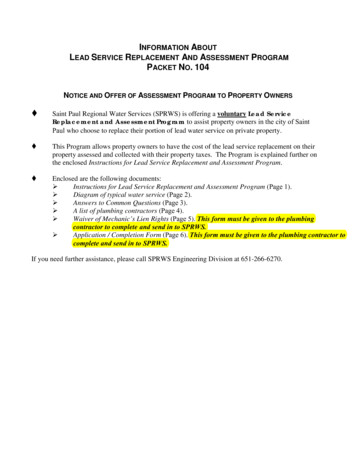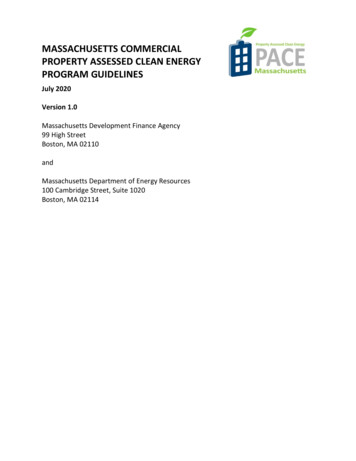
Transcription
MASSACHUSETTS COMMERCIALPROPERTY ASSESSED CLEAN ENERGYPROGRAM GUIDELINESJuly 2020Version 1.0Massachusetts Development Finance Agency99 High StreetBoston, MA 02110andMassachusetts Department of Energy Resources100 Cambridge Street, Suite 1020Boston, MA 02114
ABOUT MASSDEVELOPMENTAs the Commonwealth’s economic developmentand finance authority, MassDevelopment iscommitted to achieving three goals: Stimulating businessDriving economic growthHelping communities thrive across MassachusettsAt MassDevelopment, we offer financing and real estate solutions to support companies and nonprofits,increase housing, eliminate blight, and drive economic growth across Massachusetts. We help businesses,developers, housing, manufacturers, municipalities, and nonprofits at every stage of development.For more information on MassDevelopment, visit our website www.massdevelopment.com.ABOUT THE MASSACHUSETTS DEPARTMENT OF ENERGY RESOURCES (DOER)The Massachusetts Department of Energy Resources (DOER)develops and implements policies and programs aimed atensuring the adequacy, security, diversity, and costeffectiveness of the Commonwealth's energy supply to create aclean, affordable and resilient energy future. To that end, DOERstrives to: Ensure deployment of all cost-effective energy efficiencyMaximize development of clean energy resourcesCreate and implement energy strategies to assure reliable supplies and improve the cost of cleanenergy relative to fossil-fuel based generationSupport Massachusetts' clean energy companies and spur Massachusetts' clean energyemploymentDOER is an agency of the Executive Office of Energy and Environmental Affairs (EEA). For moreinformation on DOER, visit our website www.mass.gov/doer.Page 1
Table of Contents1. INTRODUCTION .12. TECHNICAL GUIDELINES OVERVIEW.23. FINANCIAL GUIDELINES OVERVIEW .3APPENDIX A: PACE MASSACHUSETTS APPLICATION .4APPENDIX B: TECHNICAL GUIDELINES .51. Project Technical Review.62. Project Eligibility .7A. General Eligibility . 7B. Energy Improvements eligible under PACE Massachusetts include: . 7C. Eligible Costs . 8D. Savings to Investment Ratio Test . 8E. Project Comprehensiveness Requirements. 8F. Unsatisfactory PACE Applications . 93. Project Developer Eligibility .104. Application Requirements .10A. Overview . 10B. Savings to Investment Ratio . 11C. Supporting Documentation . 12D. Energy Consumption Reduction Projects . 12E. Renewable Energy Improvement Projects . 16F. Gas Line Extensions . 18G. Design, Construction, Operation . 19H. Measurement and Verification (M&V) . 19I. Project Developer Affidavit . 20APPENDIX C: FINANCIAL GUIDELINES .201. Open Market Third Party Financing Structure .212. Underwriting Standards .213. Municipal Opt-In Provision .224. Program Fees .225. Interest Rates .226. Financing Agreement .237. Application Process .238. Application Steps .23A. Project Application . 23B. Technical Review . 24C. Mortgage Holder Consent . 24D. Financing Agreement between Property Owner and Capital provider . 24E. Betterment Assessment and Repayment . 24F. Security . 25G. Owner Disclosure Statement and Agreement . 25H. Capital provider Assignment Agreement . 25APPENDIX D: REQUEST FOR MORTGAGE HOLDER CONSENT TO PROPOSED PACE BETTERMENTASSESSMENT .27Page 2
APPENDIX E: MORTGAGE HOLDER CONSENT TO PACE BETTERMENT ASSESSMENT . 28APPENDIX F: FORM OF FINANCING AGREEMENT .29APPENDIX G: MUNICIPAL ASSESSMENT AND ASSIGNMENT AGREEMENT . 30APPENDIX H: OWNER DISCLOSURE STATEMENT AND AGREEMENT .31APPENDIX I: CAPITAL PROVIDER ASSIGNMENT AGREEMENT .32APPENDIX J: SAMPLE MODEL PACE RESOLUTION FOR MUNICIPAL OPT-IN . 33APPENDIX K: PROJECT DEVELOPER CERTIFICATION FORM .34APPENDIX L: DEFINITIONS FOR PACE MASSACHUSETTS .35Page 3
1. INTRODUCTIONProperty Assessed Clean Energy (PACE) financing is an economic development tool that gives commercialand industrial building owners access to affordable, long-term financing for energy improvements to theirbuildings. It is a national policy that promotes clean energy upgrades being charged and repaid as aproperty assessment in the same way that local public benefits (sidewalks, sewers) have been for decades.PACE financing serves an important public purpose by encouraging the construction of projects thatreduce energy costs, improve property values, reduce greenhouse gas emissions, stimulate the economyand create jobs. Property owners use PACE financing because it saves them money and makes theirbuildings more valuable.In Massachusetts, Governor Baker signed into law An Act to Promote Energy Diversity, which authorizedthe creation of a PACE program in Massachusetts. The statute, M.G.L. c. 23M (the “PACE Act”), allows forthe establishment of a commercial Property Assessed Clean Energy program (PACE Massachusetts) to beadministered by the Massachusetts Development Finance Agency (MassDevelopment) in consultationwith the Massachusetts Department of Energy Resources (DOER).Eligible properties include qualifying commercial or industrial properties, as well as multi-family buildingswith five or more units, owned by any person or entity other than a municipality or other governmentalentity. Eligible measures that can be financed include improvements that reduce energy consumption,the installation of renewable energy systems, and natural gas line extensions to supply gas to displace fueloil, electricity or other fossil fuel energy sources.PACE Massachusetts financing is different from other conventional forms of energy financing because thefinancing of the energy improvements are repaid through a voluntary betterment assessment added tothe owner’s municipal property tax bill. The betterment assessment, which is levied on the property at thefinancing close, cannot be accelerated. The financing is secured by a lien placed on the property. If theproperty is sold, the repayment obligation (remaining PACE betterment assessments) and lien transfer tothe next owner. Projected savings from the energy improvements must cover the cost of theimprovements in the allowed financing period so that, over the financing period, a property owner is notprojected to spend more than what their energy costs would have been without the improvements. PACEMassachusetts provides property owners the option to finance projects for longer periods of up to 20years which allows a property owner to include and prioritize needed improvements that could be moredifficult to fund because of the longer payback(s).PACE Massachusetts guidelines were developed in accordance with the PACE Act and contain programrequirements that participants must adhere to in order to access financing and contain the terms andconditions that proposed projects must comply with to receive approval. MassDevelopment and DOERmay amend these guidelines from time to time with or without notice. Prospective PACE Massachusettsparticipants are advised to access the current version of the PACE Massachusetts guidelines on theMassDevelopment website MassDevelopment.com/PACE.Page 1
2. TECHNICAL GUIDELINES OVERVIEWUnder PACE Massachusetts, energy improvements that are renovations or retrofits to a commercial orindustrial property or multifamily building with five or more units are eligible for financing, provided theseenergy improvements are permanently affixed to the property. Eligible commercial energy improvementsinclude: Measures that reduce energy consumption;Installation of renewable energy systems;Existing natural gas line extensions are also eligible under PACE, provided the natural gas servicedisplaces fuel oil, electricity, or other fossil-fuel energy sources.The specific project items in a commercial PACE project that are eligible for financing are: Design and procurement, including engineering and consulting services to prepare a PACEapplication, as well as legal fees and other related project costs;Construction, installation, and implementation of Energy Improvements, including barriermitigation;Related energy audits;Renewable energy system feasibility studies;Measurement and verification reports of the installation and effectiveness of EnergyImprovements (including commissioning);Financing and application fees.PACE projects must meet the savings to investment ratio (SIR) test to qualify for PACE Massachusettsfinancing. This means that the energy cost savings from the energy improvements must exceed the costsof the improvements over the life of the measures, including any financing costs and associated fees.PACE Massachusetts will help building owners reduce the impact that energy has on buildings andoperations through cost-effective energy efficiency and development of clean energy resources. An efforthas been made to align PACE Massachusetts financing with Massachusetts’ nation-leading energyefficiency and renewable energy programs. Building owners must consider both energy use reduction andrenewable energy when planning projects for PACE financing 1.The specific eligibility of improvements and the detailed technical requirements are described in moredetail in Appendix B: Technical Guidelines.1Consideration does not mean implementation, but rather that proof that thought into both energy reduction andrenewable energy options has been undertaken.Page 2
3. FINANCIAL GUIDELINES OVERVIEWPACE Massachusetts employs an open market, third party direct financing model that provides propertyowners the power to choose who will fund their project. It allows multiple capital providers to operatewithin the PACE Massachusetts program and allows property owners access to the different sources offunds that are available in the commercial PACE market. A Request for Information (RFI) process isundertaken for capital providers that are interested in offering financing for PACE Massachusettsprojects. The process and other information relevant for capital provider participation are included inAppendix C: Financial Guidelines.The financial guidelines describe the steps that an applicant goes through to apply for project review andfinancing approval under PACE Massachusetts. Upon acceptance of an application, MassDevelopment willreview for compliance with financial requirements and DOER will review for compliance with the technicalrequirements. See Appendix C for the key financial guideline criteria. We encourage participants to reviewthe project steps and information that is contained in Appendix C to help expedite the time needed todevelop projects and originate and close financing.Key components of the PACE Massachusetts financing guidelines are: Written consent is required from any mortgage holder(s) on the propertyRepayment of financing will be made via the municipal property tax collection process forremittance to a MassDevelopment-designated servicer for disbursement to PACE capital providersAnnual PACE betterment assessment is senior to and has priority over all private mortgage lienson the property (with consent, if applicable) but is junior in priority to a municipal tax lienEach municipality must opt into PACE Massachusetts (one time only) by adopting a PACEresolution via the appropriate municipal process.See Appendix C for further details on these key components.Page 3
APPENDIX A: PACE MASSACHUSETTS APPLICATIONThis is the application that must be completed and submitted to MassDevelopment for each proposedproject for PACE Massachusetts.Page 4
Application forPACE MassachusettsPROPERTY OWNER’S INFORMATION (Person to whom all correspondence will be directed)Property Owner’s NamePrimary ContactTitleAddressCityTelephoneEmailStateZip CodePrimary Contact Relationship to Property:Owner / Co-OwnerManagerProperty OwnerTypeInvestorOther (describe):CorporationSole ProprietorshipNonprofit CorporationPartnershipLimited Liability CorporationS-CorporationOther (describe):Date Property Ownership BeganList Property Owner(s) Legal Name(s) / Legally Authorized Representative (as they appear on property title; attach additional pagesif necessary)PROJECT DEVELOPER’S INFORMATION (If different from Property Owner)Project Developer’s NameProject Developer’s CompanyTitleAddressCityTelephoneEmailStateZip CodePROJECT SITE LOCATIONAddressCityCountyAssessor Parcel ID NumberStateMAZip CodePROPERTY INFORMATIONYear building was builtTotal gross building square footageConditioned Building SizeBuilding footprint, number of storiesTotal roof area and description:SlopedFlatOther (describe)Building use (List uses and Percentage)Percentage of building currently occupied:If tenant/leased, percentage of building occupied by tenants:Hours of operation:Property Type:CommercialIndustrialOccupants:Multi-family (5 Other (describe):
PROJECT INFORMATIONProposed improvements include (check all that apply)LightingHVACRoofWalls/EnvelopeCHPSolar thermalOther Renewable TechnologyWater HeatingWindowsSolar PVGas line extensionDoes the proposed project include both energy consumption reduction and renewable energy components?If no, please explain why:YesNoHave you applied for and been awarded energy efficiency financial incentives through Mass Save or your MLPEE service provider?YesNoHave you checked for, applied for, and/or been awarded renewables financial incentives with the MassachusettsClean Energy Center?YesNoAre at least 12 months of data available for all spaces and all systems for this building?(Please attach)YesNoIf not, did the project include an energy model baseline in line with PACE Technical Guidelines? (Please attach)YesNoFor solar, CHP and other renewable technologies, what is the proposed size of the system?TECHNICAL INFORMATIONName of Project Developer (if known):Check any energy efficiency audits completed (Please attach):Check studies completed (Please attach):ASHRAE Preliminary Energy auditBuilding system specific studyASHRAE Level 1ASHRAE Level 2ASHRAE Level 3Solar PV studySolar thermal studyOther Renewables studyCHP studyTOTAL ESTIMATED PROJECT FINANCING SOURCESList all anticipated sources of financing (including energy efficiency and/or renewables financial incentives, equity, etc.)Total Estimated Gross Project Costs Less:Energy efficiency incentivesRenewable energy incentivesEquityOther:Total Estimated Net Project Costs Note: Additional technical information will be required; refer to the technical guidelines for more information.
PROPERTY OWNER FINANCIAL INFORMATIONREQUESTED FINANCING AMOUNT FINANCIAL INFORMATION (Enter existing mortgage information)First Mortgage Holder :Outstanding mortgage balance: Repayment terms:Monthly payment: Remaining term of mortgage:Outstanding mortgage balance: Repayment items:Monthly payment: Remaining term of mortgageSecond Mortgage Holder:(Attach additional mortgage lenders information if necessary.)What is the assessed value of the property? (Attach a copy of current property tax bill.)Year:Assessed Value: Has an appraisal been done on the property in the past three years?Year:Appraised Value: In the last 3 years, has there been a major renovation?In the next 5 years, are any renovations planned?YesYesYesNoNoIf so, in what year?Year:NoAre there any current betterment assessments on the property?YesNoHave there been any releases of hazardous materials at or affecting the property?YesNoIs there a lien under M.G.L. Chapter 21E on the property?YesNoDo you currently pay property taxes on the property?Are all mortgage payments current?YesYesNoNoHave there been any delinquencies in mortgage payments for 60 days or more in the past 24 months?YesNoHas a foreclosure proceeding been commenced against the property in the prior 24 months?YesNoYesNoIs the property in a bankruptcy proceeding?YesIs the property owner in a bankruptcy proceeding?NoYesNoHas the property owner been subject to a bankruptcy proceeding in the past seven years?Have your property taxes ever been delinquent (by 30 days or more) in the past 3 years?Are there any tax liens or notices of default on the property?YesYesNoNoDoes the owner have sufficient net cash flow equal to or greater than the proposed annual PACE assessment?YesNoPlease provide financial statements for the past three years.Note: A capital provider will likely request additional financial information in considering an application forfinancing.
IMPORTANT NOTICEThe owner agrees to pay the Department of Energy Resources a Project Review Fee (if charged) andMassDevelopment a fee upon closing based upon a predetermined fee schedule.The representations included in this application shall survive the closing of any resulting PACEMassachusetts financing.The owner agrees that if it participates in PACE Massachusetts, it shall include MassDevelopment inany public relations events or materials related to the project, and cooperate with and permitMassDevelopment to publicize its assistance, for marketing and public relations purposes, including,but not limited to, signage, press releases, public events, and promotional materials.By submitting this request, I represent and certify to the best of my knowledge and belief that theinformation provided herein, and any exhibits or attachments hereto, is true and complete andaccurately describes the proposed project. I agree to promptly inform MassDevelopment of anychanges which may occur.SIGNATURE(S)Owner:Project Developer (if different):Name:Name:(Please print clearly)Company:(Please print clearly)Date:(Please print clearly)Company:(Please print clearly)Date:This application will be reviewed when the above requested information and the payment of the application fee of 250.00 hasbeen received by MassDevelopment.If you are not already working with us, we encourage you to call 800-445-8030 before submitting materials.Please submit application and/or questions to MassDevelopment at: 99 High Street, 11th FloorBoston, MA 02110Attn: PACE Program ManagerTel: 800-445-8030
APPENDIX B: TECHNICAL GUIDELINESThe technical guidelines describe the eligibility and requirements an applicant and project developermust follow to demonstrate energy and cost savings for a PACE project.Page 5
Pursuant to its authority under G.L. c. 25A, sec. 6(13), the Massachusetts Department of EnergyResources hereby publishes these technical guidelines for the implementation of the CommercialProperty Assessed Clean Energy program, as set forth in G.L. c. 23M.1. Project Technical ReviewThe Department of Energy Resources (DOER) will review project technical applications submitted toMass Development. 2 Project reviews will confirm whether projects meet the eligibility criteria andrequirements set forth in this Technical Guideline.DOER will issue an approval letter after a satisfactory technical review, which will contain the followinginformation: Project owner and project addressOutline of the Energy Improvements financed under PACE MassachusettsApplicant, with credentialsLifetime for the projectIf Mass Save , MassCEC or other incentives were leveragedIf benefits will flow through to tenantsAny notes from DOERDOER approval letters are valid for 12 months from the date of issue. Up to two six-month extensionsare available, at the discretion of MassDevelopment and DOER. If an application for PACEMassachusetts does not meet one or more technical requirements, DOER may take any of the followingremedial steps:1. Encourage continued communication between parties.2. Speak directly with the applicant and their project team to discuss any items that do not complywith the PACE Massachusetts program guidelines.3. Request the timely submission of remedial information.4. Review remedial information submitted by the applicant.If the application still has significant deficiencies after remedial steps have been taken, DOER may rejectthe application for not complying with the PACE Massachusetts technical program guidelines. After anapplication has been rejected, it may be updated and resubmitted for review. If an application for aproject is resubmitted after a formal rejection, the Applicant will need to restart the application process,including new application fees.To ensure that the PACE application process is efficient, Applicants with questions should contactMassDevelopment via email or phone to collaboratively work through issues before and during the2G. L. c. 25A, § 6 (13) itleII/Chapter25A/Section6Page 6
application process. A short phone call may be helpful to clarify questions about the appropriatetechnical protocol, the level of documentation required, or other details.2. Project EligibilityA. General EligibilityEnergy Improvements that qualify for PACE Massachusetts financing include renovations or retrofits of acommercial, industrial, or multifamily (five or more units) property, that are permanently fixed to theproperty. Energy Improvements must be owned by the property owner – power purchase agreementsand equipment lease agreements are not eligible for financing. PACE Massachusetts financing is onlyavailable for existing buildings; new construction and additions are not eligible. However, EnergyImprovements included in comprehensive projects that are significant enough to be considered a gutrenovation may be eligible if the project savings exceed Massachusetts base code and pass the SIR test.For example, if a building owner is considering a gut renovation of an existing building and constructinga new building on a single site, the Energy Improvements in the renovation would be eligible for PACEfinancing but the energy measures in the new building would not be eligible because they are in newconstruction. Projects can be financed for up to 20 years.B. Energy Improvements eligible under PACE Massachusetts include: Page 7Measures that reduce energy consumption (Energy Consumption Reduction Improvements):energy efficiency and conservation measures including, but not limited to, lighting and lightingcontrol upgrades, HVAC equipment upgrades, building envelope improvements, efficientelectrification, and combined heat and power (CHP). Stand-alone energy storage systems asdefined in this guideline are also eligible, as defined above.Installation of renewable energy systems (Renewable Energy Improvements): installation oftechnologies that meet requirements for RPS Class I or technologies that meet requirements asrenewable thermal generating units under the APS program, including but not limited to solarphotovoltaic panels, wind systems, anaerobic digestion, solar thermal, ground-source heatpumps, air-source heat pumps, and biomass, as defined above. Energy storage systems pairedwith eligible renewable energy systems Renewable Energy Improvements may qualify for PACEwithout meeting the consumption reduction standard for a stand-alone energy storage system,if the total project SIR is greater than one, as discussed below.Gas Line Extensions: existing gas line extensions are eligible for PACE if gas end uses will displacefuel oil, electricity or other fossil-fuel based energy sources. Projects including extensions ofexisting gas mains, gas service on the customer’s property, and the meter are eligible forfinancing. Projects displacing renewable energy systems are not eligible.
C. Eligible CostsThe specific items in a commercial PACE project that are eligible for financing are: Design and procurement, including engineering and consulting services to prepare a PACEapplication, as well as legal fees and other related project costs Construction, installation, and implementation of Energy Improvements, including barriermitigation Related energy audits Renewable energy system feasibility studies Measurement and verification reports of the installation and effectiveness of EnergyImprovements (including commissioning) Financing and application feesD. Savings to Investment Ratio TestTo qualify for PACE Massachusetts financing, PACE projects must meet the savings to investment ratio(SIR) test, as detailed in section 4(b) below. This means that the energy cost savings from the EnergyConsumption Reduction or Renewable Energy Improvements must exceed the costs of theimprovements over the life of the measures, including any financing costs and associated fees. For gasline extensions, energy costs and savings from Energy Consumption Reduction Improvements such asheating equipment upgrades will be considered in the SIR test and savings must exceed the total costs ofthe Energy Consumption Reduction Improvements and Gas Line Extension combined.E. Project Comprehensiveness RequirementsOwners and Project Developers (PD) must consider both Energy Consumption Reduction and RenewableEnergy Improvements when proposing PACE projects: For Energy Consumption Reduction Improvement projects, Renewable Energy Improvements,such as cold-climate air source heat pumps, must also be considered. Consideration does notrequire implementation, but does require documentation of the evaluation of specificRenewable Energy Improvements.For Renewable Energy Improvement projects, evidence of adopted Energy ConsumptionReduction Improvements is required.For Gas Line Extension projects, evidence of adopted Energy Consumption ReductionImprovements is required, and must be implemented to offset the investment in the SIRcalculation. Renewable Energy Improvements must also be considered, including renewable oralternative heating and cooling technologies.Substantiation of co
the creation of a PACE program in Massachusetts. The statute, M.G.L. c. 23M (the "PACE Act"), allows for the establishment of a commercial Property Assessed Clean Energy program (PACE Massachusetts) to be administered by the Massachusetts Development F inance Agency (MassDevelopment) in consultation

